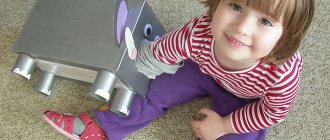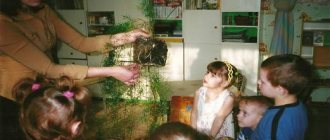The development of fine (fine) hand motor skills is extremely important for any child. This is explained by the fact that in the human brain the parts responsible for finger control and speech function are located next to each other, i.e. they can be mutually activated.
What are fine motor skills
Fine motor skills are the ability to operate small objects, pass objects to another person, and perform tasks that require hand-eye coordination. It is inextricably linked with the CNS (central nervous system), memory, vision and general perception of children.
At the initial stage of a child’s development, it is fine motor skills that indicate his intellectual abilities and general condition. Children who have insufficiently developed hand motor skills often drop pencils, forks, and spoons; it is difficult for them to lace up sneakers on their own, fasten zippers and buttons. In addition, it can be extremely difficult for them to collect scattered Lego pieces, assemble a mosaic, sort out counting sticks, etc. Therefore, such children often refuse appliqué and modeling and lag behind their peers during classes.
The importance of development
The correct development of fine motor skills contributes to the development of speech in a child, increasing his intellectual abilities and the desire for creative activity. In addition, it also affects manual dexterity, which in the future becomes the basis for reaction speed and one of the components of memory, logical thinking, prudence, imagination and attentiveness in children.
Therefore, activities for the development of fine motor skills with the help of didactic games must be included in the program for the development of speech, preparation for writing and the formation of self-care abilities in preschool children. Their subsequent development depends on how deftly children can learn to manipulate their own fingers.
Unfortunately, today many parents often forget about the importance of developing fine motor skills in children. Shoes and wardrobe items have Velcro instead of laces and buttons; not every child knits, embroiders, burns, saws with a jigsaw, helps parents wash toys, or sorts out cereals.
Today, the development of motor skills involves performing special exercises with the baby. At the same time, classes should not be boring for him, so they are organized in the form of useful and exciting didactic games.
What does it consist of?
The very first toy for any child is his hands. With their help, he begins to understand the world that surrounds him. The first tactile contact does not yet occur entirely consciously, but as the child grows older, he begins to consciously choose the movements of his fingers and hands. The subsequent development of a preschooler depends on the dexterity of finger control.
Development of fine motor skills includes:
formation of grasping movements - grabbing things of different sizes with 1 or 2 hands (balls, rattles, etc.);
grasping substances or objects with a pinch (3 fingers);
the formation of correlating actions - the ability to correctly combine 2 things or 2 parts of one thing (pyramids, inserts, nesting dolls, etc.);
development of finger control skills.
At first, the movements of the hands and fingers are clumsy, but then they become clearer and more accurate.
Age nuances
Didactic games are an excellent tool that helps comprehensively and effectively develop fine motor skills and speech function in children. Memorizing information using such gymnastics helps improve attentiveness, thinking and imagination. From an early age, children play such games as “White-sided Magpie”, “Ladushki”, etc. When bathing a baby, you can add additional devices to the games (small rubber expander, ball, etc.). In addition, after washing your baby’s hands, you can massage and wipe each of his fingers separately with a soft towel.
After 3 years, complex tasks can be introduced into games: sorting peas, beans, stringing large beads or buttons onto a string, screwing the lid of a jar or bottle, putting rings on fingers, attaching clothespins to a rope, modeling from dough, plasticine, assembling construction sets and puzzles, unfastening/fastening buttons, zippers, etc.
It is recommended to begin developing fine motor skills immediately after the baby is born. At first, you need to do a light massage, focusing on children's fingers. When the baby grows a little, he should be given toys with surfaces of different textures (rough, with pimples, smooth).
At 6 months of age, you need to buy special play equipment aimed at developing fine motor skills. Most often they have the form of a wire on which small multi-colored balls are hung. The baby must learn to move them from place to place.
At the age of 1 year, a child can already be given matryoshka dolls and pyramids of rings. Older children get construction sets with large details.
Preschool children are often offered modeling from dough or plasticine, drawing, making crafts, etc. These activities contribute to the effective development of motor skills of the child’s hands.
Popular and effective games
There are several effective exercises for preschoolers. Among them:
"Do as I do". An adult (parent or teacher) must draw some figure with his fingers. The baby must repeat the movements of the adult.
"Repeat after me". For this exercise, buttons of different colors are used. Dad, mom or teacher lays out a certain pattern on the table. The baby should draw the same figure, taking the buttons with his small fingers. If the child does not succeed the first time, the figure must be simplified and tried again. If in this case it doesn’t work out, then the child must come up with the pattern himself, and the adult repeats after him.
"Cinderella". This exercise promotes the effective development of fine motor skills. It is necessary to mix 2 types of cereals, for example, millet and peas, on a flat surface. After this, it is necessary to select the peas from the millet. To make the game as exciting as possible, you can try to compete with your child.
"A path of clothespins." Multi-colored clothespins can also provide all possible assistance in the development of motor functions. You need to take 10-15 multi-colored products and divide them into exactly 2 parts. One of the parts will be used by a child, and the other by an adult. After this, in the spirit of competition, the child should be asked to make a path out of clothespins. For this purpose, the clothespin clings to the tail one to the other.
"Kolobok smiles." First, on 2 A4 sheets you need to draw 2 buns with a nose and eyes (you don’t need to depict a smile yet). Then you need to give the baby 2 pieces of plastic mass (dough or plasticine) and ask him to make smiles for the drawn koloboks. For this purpose, the pieces are rolled out to form a long sausage. They need to be fixed in the drawings so that the koloboks get a sad or cheerful smile. Over time, the task can become more difficult. For example, you can make 2 sausages from plasticine at once, using both hands. You can also roll out the plasticine with one finger.
"Find the object." You should hide several toys in the children's sandbox. The child must try to find them by digging through the sand. This exercise is aimed at developing motor skills in children over 1-2 years old. In addition, it is undesirable to use soft toys for such games, because they will quickly become dirty.
You can come up with a large number of games yourself. For this purpose, you just need to turn on your imagination, and then everything will certainly work out!
But when performing any exercises, it must be borne in mind that they should be carried out exclusively under the supervision of an adult. This will help eliminate the possibility of small things getting into your baby's nose or mouth. In addition, it is prohibited to use prickly, sharp or other objects that could cause injury. When organizing finger games, you need to make sure that the baby’s hands are warm.
The main thing is to remember that kids develop much better when they are praised for what they do. Praise your kids even for minor achievements!
What are fine motor skills
Fine motor skills are the consistency and precision of movements required to perform various actions with small objects using the hands and fingers and toes.
Fine motor skills are evident in children from an early age, when they are just learning to hold a toy. First, the development of the hand and finger movements occurs, then the formation of speech is formed. The formation of speech through the development of fine motor skills occurs due to the influence of nerve endings on the parts of the brain responsible for motor skills and speech, which are located next to each other.
In addition to the main function - speech development - fine motor skills influence the development of mental processes: thinking, memory, imagination, and the ability to navigate in space.





